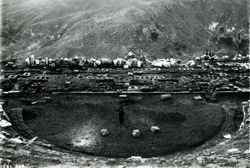The Introduction of Photography as a Practice in Archaeological Documentation since the Late 19th Century
Archival Program Information
For current Research Institute events, please see The Getty Event Calendar
For current Research Institute events, please see The Getty Event Calendar
Lecture

|
|
Thursday, January 12, 2012
5:30 p.m.
Getty Research Institute Lecture Hall
The Getty Center
As a science based on objects, archaeology requires illustration. For this reason, reproductions played an important role from the field's inception. This need for visual documentation motivated the founding of the world's first archaeological institute, the Istituto di Corrispondenza Archeologica in Rome.
Although photography's potential applications were discussed immediately after its invention in the 1820s, it was not adopted by archaeologists until the 1860s. This new medium was first tested on objects and during travels, after which it was used on corpora projects and large-scale excavations in Greece and Asia Minor, where it initially documented excavation sites and then finds.
It was not until the 1890s that the medium finally entered the lecture halls of German universities in the form of the slide projector. Photography was one of several media at the disposal of archaeologists of the period. The debate among archaeologists about the pros and cons of photography arose from its technical character, which enabled it to depict objects faithfully and accurately and thus to become a means of objective representation. In this lecture, scholar Ortwin Dally discusses photography's status in archaeology in the second half of the 19th century as well as its relationship to other forms of objective or idealized visual representation.
Ortwin Dally is Secretary-General of the German Archaeological Institute (DAI) and honorary professor of archaeology at the Freie Universität Berlin.
5:30 p.m.
Getty Research Institute Lecture Hall
The Getty Center
As a science based on objects, archaeology requires illustration. For this reason, reproductions played an important role from the field's inception. This need for visual documentation motivated the founding of the world's first archaeological institute, the Istituto di Corrispondenza Archeologica in Rome.
Although photography's potential applications were discussed immediately after its invention in the 1820s, it was not adopted by archaeologists until the 1860s. This new medium was first tested on objects and during travels, after which it was used on corpora projects and large-scale excavations in Greece and Asia Minor, where it initially documented excavation sites and then finds.
It was not until the 1890s that the medium finally entered the lecture halls of German universities in the form of the slide projector. Photography was one of several media at the disposal of archaeologists of the period. The debate among archaeologists about the pros and cons of photography arose from its technical character, which enabled it to depict objects faithfully and accurately and thus to become a means of objective representation. In this lecture, scholar Ortwin Dally discusses photography's status in archaeology in the second half of the 19th century as well as its relationship to other forms of objective or idealized visual representation.
Ortwin Dally is Secretary-General of the German Archaeological Institute (DAI) and honorary professor of archaeology at the Freie Universität Berlin.